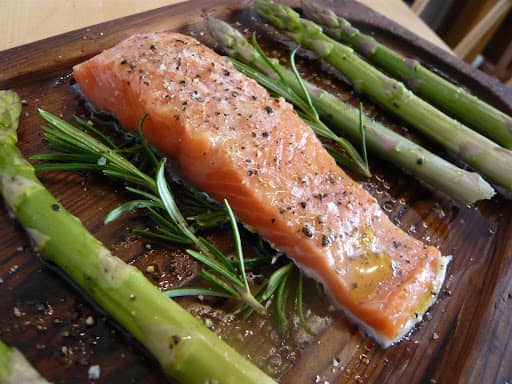
In need of an easy and impressive meal to add to your recipe rotation? Baked salmon is an excellent way to go! Quick, healthy, and delicious you can feed a crowd in just a few minutes with relative ease.
We recommend beginning with wild-caught salmon fillets, which are rich in flavor as well as protein, healthy fats, vitamins and minerals. Here at Maine Lobster House, we work with local fisherman to source the best wild-caught salmon and deliver it directly to your door.
With high quality salmon in hand, all you really need is a few simple ingredients for a truly delicious meal.
To begin, we recommend starting with defrosted fish. Remove fish from vacuum packaging to defrost, placing fillets in a resealable plastic bag. If time permits, defrost in the refrigerator overnight. If not, simply place the zip top bag in a bowl of cool water for about 15-20 minutes until defrosted. Once your salmon is thawed, you can begin cooking!
What You’ll Need:
Tools:
- Sheet Pan
- Aluminum Foil
- Fish Spatula
Ingredients:
- 4 Wild-Caught Salmon Filets
- 4 tablespoons of Olive Oil
- 1-2 lemons
- Salt (to taste)
- 4 teaspoons of black pepper
- Fresh herbs (such as parsley or dill)
Instructions for Baking Salmon
- To begin preparing oven baked salmon, preheat your oven to 425 degrees Fahrenheit.
- While the oven is preheating, line a baking sheet with aluminum foil and prepare the salmon.
- Place the salmon filets, skin side down, on the baking sheet and drizzle each filet with 1 tablespoon of olive oil. Sprinkle each filet with salt (to taste) and 1 teaspoon of black pepper. (If desired, add additional flavors such as garlic powder or paprika to taste).
- Next, squeeze the juice of 1 lemon over all 4 filets.
- Once the salmon is prepped and oven is heated, place the baking sheet in the center of the oven. Let cook for about 15 minutes. Thicker filets may require additional cooking.
- Check for doneness of the salmon by inserting a cooking thermometer into the thickest part of the filet. The temperature should read 145 degrees Fahrenheit. (Other indicators of doneness include texture and color. Cooked salmon will be an opaque pink when cooked, and will easily flake with a fork.)
- Using a fish spatula, carefully remove the baked salmon from the sheet pan and serve.
- Enjoy baked salmon with a squeeze of fresh lemon and fresh herbs of your choosing like parsley or dill.
While this simple preparation is likely to please varying taste-buds, the best part about baked salmon is the versatility! Feel free to customize the flavors of each filet with different seasonings or sauces to please any one of your dinner guests. Serve baked salmon with a simple side like asparagus and brown rice or a fresh salad for a light and delicious meal!
For more recipes and inspiration, browse our Seafood University, or get straight to cooking by placing an order with us today!

Baked Salmon
Equipment
- sheet pan
- aluminum foil
- flat spatula
Ingredients
- 4 wild-caught salmon filets
- 4 tbsp olive oil
- 1-2 lemons
- salt, to taste
- 4 tsp black pepper
- fresh herbs (such as parsley or dill)
Instructions
- To begin preparing oven baked salmon, preheat your oven to 425 degrees Fahrenheit.
- While the oven is preheating, line a baking sheet with aluminum foil and prep the salmon.
- Place the salmon filets, skin side down, on the baking sheet and drizzle each filet with 1 tablespoon of olive oil. Sprinkle each filet with salt (to taste) and 1 teaspoon of black pepper. (If desired, add additional flavors such as garlic powder or paprika to taste).
- Next, squeeze the juice of 1 lemon over all 4 filets.
- Once the salmon is prepped and oven is heated, place the baking sheet in the center of the oven. Let cook for about 15 minutes. Thicker filets may require additional cooking.
- Check for doneness of the salmon by inserting a cooking thermometer into the thickest part of the filet. The temperature should read 145 degrees Fahrenheit. (Other indicators of doneness include texture and color. Cooked salmon will be an opaque pink when cooked, and will easily flake with a fork.)
- Using a fish spatula, carefully remove the baked salmon from the sheet pan and serve.
- Enjoy baked salmon with a squeeze of fresh lemon and fresh herbs of your choosing like parsley or dill.

